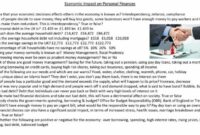Balancing luxury lifestyle with financial responsibility isn’t about sacrificing enjoyment; it’s about smart choices. This exploration dives into the art of living well without jeopardizing your future. We’ll examine how to define your personal version of luxury, create a budget that works for you, and build long-term financial security. It’s about understanding the psychology behind spending and making conscious decisions that align with your values and goals.
From crafting a budget that incorporates both lavish experiences and smart investments to understanding the ethical implications of luxury consumption, we’ll navigate the complexities of this delicate balance. We’ll uncover strategies for mindful spending, explore effective wealth management techniques, and delve into the importance of long-term financial planning and legacy building. Ultimately, this guide aims to empower you to create a lifestyle that reflects your aspirations while ensuring lasting financial well-being.
Defining “Luxury Lifestyle” and “Financial Responsibility”
Balancing a luxurious lifestyle with financial responsibility requires a clear understanding of both concepts. These aren’t mutually exclusive, but rather represent different approaches to managing resources and prioritizing life goals. A successful balance hinges on defining personal values and aligning spending habits with long-term financial well-being.
Luxury Lifestyle Defined
A luxury lifestyle encompasses more than just expensive possessions. It’s a holistic experience encompassing material goods, exclusive services, and curated experiences designed to enhance quality of life. Possessions might include high-end vehicles, designer clothing, or opulent real estate. Services could range from private chefs and personal trainers to first-class travel and bespoke tailoring. Crucially, a luxury lifestyle also involves access to unique experiences – private concerts, exclusive travel destinations, or VIP access to events.
The social status associated with a luxury lifestyle can be a significant factor, often involving networking within specific social circles and participation in exclusive events. The definition, however, is highly subjective and varies greatly depending on individual values and socioeconomic background. For one person, a luxury lifestyle might involve owning a comfortable home and taking occasional weekend getaways; for another, it might necessitate a private jet and a sprawling estate.
Financial Responsibility Defined
Financial responsibility centers on mindful management of personal finances to achieve long-term financial security. It’s a proactive approach that involves several key components. Budgeting is fundamental, allowing for tracking income and expenses to ensure spending remains within means. Saving is crucial for building a financial safety net to cover unexpected expenses and achieve future goals. Investing allows for growth of capital over time, potentially generating passive income and securing financial independence.
Effective debt management is essential, minimizing high-interest debt and strategically using credit to one’s advantage. Financial responsibility, unlike a luxury lifestyle, isn’t defined by specific amounts or possessions, but rather by responsible and sustainable financial practices.
Socioeconomic Interpretations of Luxury and Responsibility
Different socioeconomic groups hold varying interpretations of both luxury and financial responsibility. For high-net-worth individuals, a luxury lifestyle might involve extravagant spending on private jets and yachts, while financial responsibility focuses on preserving and growing wealth through diversified investments and tax optimization strategies. In contrast, for middle-class individuals, a luxury lifestyle might involve regular vacations and a comfortable home, with financial responsibility revolving around careful budgeting, saving for retirement, and managing student loan debt.
Lower-income individuals may define luxury as simply affording basic necessities and having enough for small comforts, while financial responsibility centers on avoiding debt and securing affordable housing. The core principle remains consistent: the balance between desires and resources, but the scale and definition of both luxury and responsibility shift drastically across the socioeconomic spectrum.
Budgeting and Expense Management for a Luxury Lifestyle
Maintaining a luxurious lifestyle doesn’t necessitate reckless spending. Careful budgeting and expense management are crucial to ensuring financial responsibility and long-term stability. This involves a strategic approach to allocating funds across various categories while still enjoying the finer things in life. The key is to balance desires with fiscal prudence.
Sample Luxury Lifestyle Budget
A sample budget needs to be tailored to individual circumstances, income, and desired lifestyle. However, a general framework can be useful. This example assumes an annual income of $250,000 after tax. Remember, these figures are illustrative and should be adjusted based on your personal financial situation.
| Category | Percentage of Income | Approximate Monthly Amount | Notes |
|---|---|---|---|
| Necessities (Housing, Utilities, Groceries, Transportation) | 25% | $5208 | Prioritize efficient but high-quality options. |
| Discretionary Spending (Dining, Travel, Entertainment, Personal Care) | 40% | $8333 | Allocate funds strategically, focusing on experiences over material possessions. |
| Investments (Retirement, Stocks, Real Estate) | 25% | $5208 | Consistent investment is key to long-term financial security. |
| Savings (Emergency Fund, Other Goals) | 10% | $2083 | Maintain a robust emergency fund to cover unexpected expenses. |
Expense Tracking and Savings Strategies
Effective expense tracking is paramount. Utilize budgeting apps, spreadsheets, or even a simple notebook to meticulously record all income and expenses. Categorize your spending to identify areas of overspending. For example, you might discover that restaurant meals or frequent shopping trips are exceeding your budget.Several strategies can help identify areas for potential savings:* Prioritize Experiences over Possessions: Focus on creating memories through travel, fine dining, or unique experiences rather than accumulating material possessions.
Negotiate Prices
Don’t be afraid to negotiate prices for high-ticket items like cars or jewelry.
Seek Value
Look for value rather than solely focusing on brand names. Many lesser-known brands offer comparable quality at a lower price.
Utilize Rewards Programs
Maximize rewards programs on credit cards and loyalty programs to earn points or cashback.
Regularly Review Your Budget
Regularly review and adjust your budget to reflect changes in income or spending habits.
Luxury Goods and Services: Cost Comparison and Alternatives
Comparing the cost of luxury goods and services against more affordable alternatives allows for informed decision-making without compromising on quality or experience.
| Luxury Item | Luxury Cost | Affordable Alternative | Alternative Cost |
|---|---|---|---|
| First-Class International Flight | $10,000 | Business Class Flight | $4,000 |
| Luxury Watch (Rolex) | $10,000+ | High-End Mechanical Watch (Tissot) | $1,000 – $3,000 |
| Designer Handbag (Hermes Birkin) | $10,000+ | High-Quality Leather Handbag (Mansur Gavriel) | $500 – $1,000 |
| Five-Star Hotel Stay | $1,000+/night | Boutique Hotel Stay | $300 – $500/night |
Investing and Wealth Management Strategies: Balancing Luxury Lifestyle With Financial Responsibility
Maintaining a luxurious lifestyle while ensuring long-term financial security requires a sophisticated approach to investing and wealth management. It’s not just about accumulating wealth; it’s about strategically growing and protecting it to support your desired lifestyle for years to come. This involves a combination of prudent risk management, diversified investments, and a well-defined financial plan.Investing for a luxury lifestyle necessitates a long-term perspective.
Short-term market fluctuations should be viewed as noise, not signals to drastically alter your strategy. The focus should be on consistent, steady growth that outpaces inflation and allows for the ongoing enjoyment of your lifestyle choices.
Long-Term Investment Strategies
Successful long-term investing for maintaining a luxury lifestyle typically involves a mix of asset classes designed to balance growth potential with risk mitigation. This might include a portfolio comprising stocks (both large-cap and small-cap for diversification), bonds (for stability and income), real estate (for potential appreciation and rental income), and alternative investments (such as private equity or hedge funds, depending on risk tolerance and expertise).
The specific allocation will depend on individual circumstances, risk tolerance, and financial goals. For example, a younger individual with a higher risk tolerance might allocate a larger percentage to stocks, while someone closer to retirement might prefer a more conservative approach with a greater emphasis on bonds and fixed-income securities. The key is to regularly review and adjust the portfolio as circumstances change.
Diversification and Risk Mitigation
Diversification is paramount in any investment strategy, but it’s especially crucial when aiming to sustain a luxury lifestyle. By spreading investments across different asset classes and geographies, you reduce the impact of any single investment’s underperformance. If one sector experiences a downturn, the losses are offset by gains in other areas. For instance, a portfolio heavily weighted in technology stocks might suffer significantly during a tech sector correction, whereas a diversified portfolio would likely experience a much less dramatic impact.
This strategy aims to minimize volatility and protect your capital, allowing you to maintain your desired lifestyle even during periods of market uncertainty. It’s also important to consider diversification across different investment managers, to mitigate risks associated with a single firm’s investment decisions.
Creating a Comprehensive Financial Plan
A comprehensive financial plan is the cornerstone of successfully balancing luxury living with financial responsibility. This plan should incorporate both short-term and long-term goals. Short-term goals might include funding annual vacations, covering expenses related to luxury goods, or making home improvements. Long-term goals would focus on retirement planning, estate planning, and ensuring the long-term financial security of your family. The plan should detail your current financial situation, including assets, liabilities, and income, and then Artikel a clear roadmap for achieving your goals.
This roadmap should include specific investment strategies, risk tolerance levels, and regular review periods to ensure the plan remains aligned with your evolving circumstances and financial objectives. Consider seeking advice from a qualified financial advisor to create a personalized plan tailored to your specific needs and aspirations. A financial advisor can help you navigate the complexities of investing and wealth management, ensuring you’re making informed decisions to protect and grow your wealth.
The Psychology of Spending and Consumer Behavior

Source: co.id
The pursuit of a luxury lifestyle often intersects with complex psychological factors that influence spending habits. Understanding these influences is crucial for maintaining financial responsibility while still enjoying the finer things in life. Overspending isn’t simply a matter of poor budgeting; it’s frequently driven by deeply ingrained psychological tendencies and emotional responses to marketing and social pressures.Understanding these psychological drivers allows for the development of targeted strategies to manage spending and cultivate healthier financial habits.
By recognizing the emotional triggers behind impulsive purchases, individuals can consciously shift their relationship with money and luxury goods, fostering a more balanced and sustainable approach.
Common Psychological Factors Influencing Spending Habits
Several psychological factors contribute to overspending, particularly when striving for a luxury lifestyle. These include the impact of social comparison, the allure of instant gratification, and the power of marketing and advertising. For instance, the constant exposure to aspirational lifestyles on social media can fuel a sense of inadequacy and trigger impulsive purchases aimed at closing the perceived gap.
Similarly, the immediate pleasure derived from acquiring a luxury item can override long-term financial planning, leading to overspending and subsequent regret. Clever marketing techniques, such as limited-time offers and exclusive access, further exploit these psychological vulnerabilities.
Strategies for Managing Impulsive Spending and Cultivating Mindful Consumption
Managing impulsive spending requires a multi-pronged approach that combines conscious awareness with practical strategies. One effective technique is the “waiting period” strategy: before making a significant purchase, wait a predetermined amount of time (e.g., 24-48 hours) to assess the purchase’s true necessity. This allows for a cooling-off period, separating the immediate emotional desire from the rational evaluation of the purchase’s long-term impact.
Another crucial step is budgeting and tracking expenses meticulously. This transparency helps individuals understand their spending patterns, identifying areas where they can cut back and redirect funds towards long-term financial goals. Finally, cultivating mindfulness involves actively paying attention to the emotions and motivations behind purchases. Journaling can be a powerful tool to track spending triggers and reflect on the emotional state during purchases.
By understanding these triggers, individuals can develop coping mechanisms and make more conscious choices.
Approaches to Financial Therapy and Counseling
Financial therapy and counseling offer structured support in addressing the psychological aspects of spending and debt management. Cognitive Behavioral Therapy (CBT) is a common approach that helps individuals identify and modify negative thought patterns and behaviors related to money. CBT techniques focus on reframing unhelpful beliefs about money and luxury, such as the belief that happiness is directly proportional to material possessions.
Financial counseling, on the other hand, often takes a more practical approach, focusing on budgeting, debt reduction strategies, and developing a long-term financial plan. Some therapists integrate both approaches, providing a holistic framework for addressing both the psychological and practical aspects of financial well-being. For example, a therapist might help a client identify their emotional triggers for luxury spending (e.g., stress, low self-esteem) while simultaneously working with them to create a realistic budget and debt repayment plan.
The choice between CBT-focused therapy and financial counseling depends on individual needs and preferences, but both can provide valuable support in navigating the complexities of balancing luxury with financial responsibility.
Long-Term Financial Planning and Legacy Building

Source: dreamstime.com
Maintaining a luxurious lifestyle while ensuring long-term financial security and building a legacy requires a proactive and comprehensive approach. This involves not only managing current expenses but also strategically planning for future life events and the eventual transfer of wealth to future generations. A well-defined plan ensures your desired lifestyle is sustainable across decades, providing financial stability for you and your loved ones.
Developing a robust long-term financial plan necessitates considering various factors and implementing specific strategies. This includes anticipating life changes, making informed investment decisions, and establishing a clear estate plan. Failing to plan adequately can jeopardize your ability to maintain your lifestyle and potentially leave your family vulnerable.
Developing a Long-Term Financial Plan
A comprehensive long-term financial plan should account for various life stages and potential changes. This involves projecting future income and expenses, considering inflation, and adjusting the plan as needed. For example, the financial needs of a young couple will differ significantly from those of a retired couple. The plan should Artikel specific goals, such as funding children’s education, purchasing a second home, or ensuring sufficient retirement income.
Regular review and adjustments are crucial to keep the plan aligned with evolving circumstances and financial goals. Consider consulting with a financial advisor to create a personalized plan that accounts for your unique circumstances and aspirations. A realistic plan will incorporate scenarios like potential job loss, unexpected medical expenses, or changes in market conditions.
Legacy-Building Strategies
Legacy building involves more than just accumulating wealth; it’s about thoughtfully preserving and transferring assets to future generations. Several strategies can be employed, including establishing trusts, creating charitable foundations, and making strategic investments. Trusts, for example, can help protect assets from creditors and ensure that they are distributed according to your wishes. Charitable foundations allow you to support causes you care about while potentially benefiting from tax advantages.
Strategic investments in assets that appreciate over time, such as real estate or diversified investment portfolios, can provide long-term financial security for your family. Careful consideration should be given to minimizing tax implications and ensuring the assets are managed effectively. For instance, establishing a family limited partnership (FLP) can offer tax advantages and help maintain control over assets.
Estate Planning for Preserving Family Lifestyle and Financial Stability
Estate planning is crucial for preserving a family’s lifestyle and financial stability across generations. A comprehensive estate plan should include a will, a durable power of attorney, a healthcare power of attorney, and potentially trusts. The will Artikels how your assets will be distributed after your death. A durable power of attorney designates someone to manage your financial affairs if you become incapacitated.
A healthcare power of attorney appoints someone to make healthcare decisions on your behalf if you are unable to do so. Trusts can be used to protect assets, minimize taxes, and provide for beneficiaries over time. Consider seeking professional legal and financial advice to ensure your estate plan is properly structured and meets your specific needs. Proper estate planning also includes minimizing estate taxes and probate fees, which can significantly reduce the assets passed on to heirs.
Detailed instructions regarding the management and distribution of assets should be included, especially for complex holdings.
Ethical Considerations of Luxury Consumption
The pursuit of a luxurious lifestyle inevitably raises ethical questions. While enjoying high-quality goods and experiences can enhance well-being, it’s crucial to consider the broader impact of our consumption habits on the environment and society. The ethical dimension of luxury necessitates a careful examination of production processes, material sourcing, labor practices, and the overall environmental footprint.The environmental impact of luxury goods is significant.
Many luxury items are crafted from resource-intensive materials, such as rare woods, precious metals, and exotic animal skins. Their production often involves energy-intensive processes and generates considerable waste. Furthermore, the transportation of these goods across the globe contributes to carbon emissions. Socially, concerns arise regarding fair labor practices within the supply chains of luxury brands. Exploitation of workers, including low wages, unsafe working conditions, and child labor, remains a persistent challenge in some sectors.
Therefore, responsible luxury consumption requires a conscious effort to make informed choices and support brands committed to sustainability and ethical practices.
Environmental Sustainability in Luxury, Balancing luxury lifestyle with financial responsibility
Luxury brands are increasingly acknowledging the need for environmental responsibility. Several strategies are being implemented to minimize the environmental impact of luxury production. This includes the use of recycled materials, sustainable sourcing of raw materials (e.g., sustainably harvested timber, recycled metals), and the adoption of eco-friendly manufacturing processes that reduce energy consumption and waste. Some brands are also investing in carbon offsetting programs to compensate for their carbon footprint.
For instance, Stella McCartney, a prominent luxury fashion house, is known for its commitment to sustainable materials and ethical production methods. They utilize organic cotton, recycled fabrics, and innovative materials like mushroom leather, aiming to minimize environmental harm. Similarly, some luxury watchmakers are exploring the use of recycled gold and other sustainable materials in their timepieces. The shift towards circular economy models, where products are designed for durability, repairability, and recyclability, is also gaining traction within the luxury sector.
Social Responsibility in Luxury
Beyond environmental concerns, ethical luxury consumption also necessitates attention to social responsibility. This involves ensuring fair labor practices throughout the supply chain, promoting worker well-being, and supporting communities impacted by luxury production. Transparency in supply chains is crucial for identifying and addressing potential human rights violations. Several luxury brands are actively working to improve their supply chain transparency and traceability, implementing ethical sourcing policies, and conducting regular audits to ensure compliance with fair labor standards.
Examples include companies that publish detailed reports on their supply chain practices and actively engage with NGOs and independent organizations to monitor their social impact. Furthermore, some luxury brands are investing in community development projects in regions where their products are sourced, contributing to local economic growth and improving the lives of those involved in the production process.
Patagonia, though not strictly a luxury brand, serves as a strong example of a company deeply committed to social and environmental responsibility, demonstrating that ethical practices are not mutually exclusive with business success.
Alternative Lifestyle Choices for Ethical Luxury
Making conscious choices is key to balancing luxury with ethical considerations.
- Prioritize quality over quantity: Invest in fewer, higher-quality items that are durable and long-lasting, reducing the need for frequent replacements.
- Support ethical and sustainable brands: Research brands committed to transparency, fair labor practices, and environmental sustainability.
- Choose secondhand or vintage luxury: Giving pre-owned luxury items a new life reduces demand for newly produced goods and minimizes environmental impact.
- Embrace experiences over material possessions: Prioritize travel, cultural events, and personal development experiences over accumulating material goods.
- Support local artisans and craftspeople: Purchasing handcrafted items from local artisans promotes sustainable practices and supports local economies.
- Minimize waste and practice conscious consumption: Reduce, reuse, and recycle to minimize your environmental footprint.
- Advocate for ethical and sustainable practices: Support companies and organizations committed to ethical and sustainable practices, and encourage others to do the same.
Visualizing the Balance
Successfully integrating a luxury lifestyle with sound financial practices requires careful planning, mindful spending, and a long-term perspective. It’s not about deprivation, but about conscious choices that align personal values with financial realities. This section explores scenarios illustrating both successful integration and the potential pitfalls of neglecting financial responsibility.
A Successful Balance: The Story of Anya
Anya, a successful architect, enjoys a luxurious lifestyle that includes a spacious city apartment, regular international travel, and high-quality experiences. However, her luxury isn’t impulsive. Her daily routine includes dedicated time for financial management. She meticulously tracks her expenses using budgeting apps, automatically transferring a significant portion of her income into diversified investment accounts. She prioritizes experiences over material possessions, often opting for unique travel adventures over designer clothes.
Anya’s long-term planning involves a robust retirement plan, and she regularly reviews her investment portfolio with a financial advisor. This conscious approach allows her to indulge in luxuries without compromising her long-term financial security. Her financial habits are not just about tracking numbers; they are integral to her lifestyle, reflecting her values and long-term goals. She understands that financial freedom fuels her ability to enjoy her chosen luxuries sustainably.
Consequences of Neglecting Financial Responsibility
Conversely, consider Liam, a young entrepreneur who rapidly amassed wealth. Driven by a desire for immediate gratification, Liam embraced a lavish lifestyle characterized by impulsive purchases of luxury cars, designer clothing, and extravagant parties. He neglected to create a budget, track his expenses, or invest wisely. His lifestyle became unsustainable, leading to mounting debt and significant financial strain.
He eventually faced the difficult choice of selling assets to cover debts, ultimately compromising his lifestyle and causing considerable stress. This scenario highlights the importance of financial planning and responsible spending, even in the context of significant income. Liam’s story serves as a cautionary tale of how neglecting financial responsibility, even with high earnings, can lead to devastating consequences.
Visualizing a Balanced Lifestyle
Imagine a vibrant, balanced scale. On one side, a delicately crafted, ornate bowl overflows with experiences: a shimmering golden globe representing international travel, a stack of worn books representing knowledge and personal growth, and vibrant paintings symbolizing artistic appreciation. These represent the luxury elements, the enriching experiences that add quality to life. On the other side, a sturdy, secure vault represents financial prudence.
This vault is not cold or empty, but instead contains gleaming gold bars representing investments, carefully organized documents symbolizing financial planning, and a small, but steady stream of coins flowing into it, symbolizing consistent savings. The scale is perfectly balanced, demonstrating the harmony between indulging in life’s luxuries and maintaining a strong financial foundation. The overall image conveys a sense of serenity and control, illustrating that a fulfilling life doesn’t require sacrificing one for the other.
It’s a picture of mindful indulgence, a testament to the power of conscious choices and long-term vision.
Wrap-Up
Ultimately, achieving a balanced luxury lifestyle is a journey, not a destination. It requires mindful planning, disciplined spending, and a commitment to long-term financial health. By understanding your spending habits, prioritizing your financial goals, and making informed choices, you can cultivate a lifestyle that seamlessly integrates both opulence and responsibility. Remember, true luxury isn’t just about the possessions you accumulate, but the freedom and security you create for yourself and your future.
FAQ Explained
Can I still enjoy luxury items on a budget?
Absolutely! Prioritizing and strategically choosing luxury items over impulse purchases is key. Consider renting high-end items occasionally instead of buying them outright, or opting for slightly less expensive, but still high-quality, alternatives.
What if my income fluctuates? How can I plan for that?
Incorporate a buffer into your budget for unexpected income changes. Having an emergency fund is crucial, and you may need to adjust your spending habits accordingly during periods of lower income. Consider flexible investment strategies that allow for adjustments based on market conditions.
How do I talk to a financial advisor about my luxury lifestyle goals?
Be open and honest about your aspirations. A good advisor will help you create a realistic plan that balances your desires with sound financial strategies. Provide them with a clear picture of your income, expenses, and long-term goals.
What are some ethical luxury brands?
Research brands that prioritize sustainable practices, fair labor standards, and transparency in their supply chains. Look for certifications and independent reports that verify their ethical claims.
Is it possible to maintain a luxury lifestyle and still retire comfortably?
Yes, but it requires careful planning and discipline. Early and consistent saving and investing, coupled with a well-structured budget, are essential to ensure a comfortable retirement while enjoying a luxurious lifestyle now.





